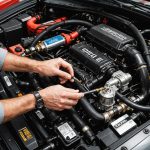Maximizing Safety: Essential Tips for Ensuring Your Vehicle’s Automatic Transmission Operates at Peak Performance
When it comes to ensuring your vehicle’s automatic transmission operates at its best, safety and performance go hand in hand. Here are some essential tips to help you maintain your car’s transmission, prevent costly repairs, and ensure optimal performance.
Regular Maintenance: The Backbone of Transmission Health
Regular maintenance is the cornerstone of keeping your vehicle’s automatic transmission in top shape. Here are some key aspects to focus on:
Schedule Regular Inspections
Regular inspections are crucial for identifying potential issues before they become major problems. Set up a maintenance schedule that includes checks on key components such as the transmission fluid, engine, brakes, and tires. Use fleet management software or consult with your repair shop to automate these schedules and track your vehicle’s health[1].
Check Your Transmission Fluid
Transmission fluid is vital for the proper functioning of your automatic transmission. Regularly check the fluid levels and quality to ensure effective cooling and lubrication. Low or degraded fluid can lead to increased friction, causing overheating and potentially severe damage to your transmission.
Topic to read : Ensuring Backup Sensor Reliability in Urban Driving: Tips for Savvy Drivers
### Transmission Fluid Check Schedule
- **Every 30,000 to 60,000 miles:** Inspect the fluid for signs of contamination or a burnt smell.
- **Every 60,000 to 100,000 miles:** Change the transmission fluid to maintain optimal performance.
Use High-Quality Fluid
Using high-quality transmission fluid is an investment in the longevity and safety of your vehicle. Ensure that the fluid meets the specifications recommended by your car’s manufacturer. As noted by automotive experts, “Maintaining your transmission oil is an investment in the longevity and safety of your vehicle”[5].
Driving Techniques to Prevent Transmission Issues
Mindful driving techniques can significantly reduce the strain on your transmission and prevent overheating.
Smooth Driving
Encourage smooth driving habits such as accelerating and braking smoothly. Avoid aggressive acceleration, hard braking, and speeding, as these can cause excessive wear on your vehicle’s components, including the transmission[1].
Effective Gear Shifting Strategies
Proper gear shifting is crucial in maintaining optimal transmission temperature. Avoid holding gears too long, as this can lead to excessive heat build-up. Instead, shift gears smoothly and timely to keep the engine and transmission operating efficiently[2].
Managing RPMs
High RPMs can significantly increase transmission temperature. Avoid pushing the engine to its redline, as this generates unnecessary heat. Instead, aim for a balanced RPM range that provides sufficient power without overburdening the transmission[2].
Tire Maintenance and Its Impact on Transmission
While tire maintenance might seem unrelated to transmission health, it plays a crucial role in overall vehicle performance and safety.
Regular Tire Pressure Checks
Ensure that your tires are inflated to the correct pressure. Under-inflated tires increase fuel consumption and wear out more quickly, while over-inflated tires can reduce traction and increase the risk of blowouts. Proper tire pressure also improves fuel efficiency and reduces wear on the vehicle, including the transmission[1].
Wheel Alignment and Rotation
Regularly align and rotate your tires for even wear. This helps extend tire life and improves vehicle handling, which in turn reduces the strain on the transmission system.
Fuel Management and Its Effects on Transmission
Fuel management is another critical aspect that can impact your transmission’s performance and longevity.
Monitor Fuel Consumption
Use telematics systems to track fuel usage across your fleet. This data can help identify inefficiencies and areas where fuel consumption can be reduced. Limit idling and optimize routes to reduce unnecessary driving, which saves fuel and reduces wear on the vehicle, including the transmission[1].
Avoid Frequent Low Fuel Levels
Driving frequently with low fuel levels can cause the fuel pump to work harder, which may lead to increased heat generation and strain on the engine and transmission. Ensure your car has an adequate amount of fuel, especially in diesel vehicles, to maintain optimal performance and prevent overheating[4].
Common Mistakes to Avoid in Automatic Cars
There are several common mistakes that drivers make which can harm the transmission and overall performance of their automatic car.
Avoid Switching to ‘Park’ Before Stopping
Never switch to ‘Park’ before your automatic car comes to a complete stop. This can harm the transmission and cause costly repairs. The parking gear is meant to hold the car still while it is parked, not to act as a brake[4].
Never Rest Your Hand on the Gear Stick
Resting your hand on the gear stick can put pressure on the shifter rail, leading to premature wear and tear on the gears. This can cause friction and damage to the gear teeth, resulting in transmission problems[4].
Avoid Switching to Neutral While Driving
Switching to neutral while driving reduces control over the car and can be dangerous, especially in risky situations. It also stops the flow of fuel to the engine, relying solely on the main brakes, which can put more strain on them[4].
Creating a Maintenance Checklist
Developing a maintenance checklist can help you stay organized and proactive in maintaining your vehicle.
Regular Inspections
Include routine inspections of key components such as the transmission fluid, engine oil, brakes, and tires.
Fluid Changes
Schedule regular fluid changes for your transmission, engine, and other critical systems.
Cooling System Maintenance
Ensure the radiator and auxiliary coolers are in top condition to prevent heat build-up.
### Sample Maintenance Checklist
| **Component** | **Frequency** | **Action** |
|
|-------------------------|
|
| Transmission Fluid | Every 30,000 to 60,000 miles | Check levels and quality, change if necessary |
| Engine Oil | Every 5,000 to 7,500 miles | Check levels, change if necessary |
| Brakes | Every 10,000 to 15,000 miles | Inspect brake pads and rotors |
| Tires | Monthly | Check tire pressure, inspect for damage |
| Cooling System | Every 6 months | Inspect radiator and auxiliary coolers |
Practical Insights and Actionable Advice
To ensure your vehicle’s automatic transmission operates at peak performance, here are some practical insights and actionable advice:
Train Your Drivers
Educate your drivers on the importance of smooth driving, speed management, and regular vehicle checks. This can significantly reduce maintenance costs and extend the lifespan of your fleet[1].
Use Advanced Technology
Utilize telematics systems and fleet management software to track vehicle health, automate maintenance schedules, and record service history. This helps in early detection of issues and prevents costly repairs[1].
Consult Professionals
If you notice any unusual noises, vibrations, or warning lights, do not hesitate to consult a professional mechanic. Early detection and repair can save you from more severe and costly transmission issues.
Maintaining your vehicle’s automatic transmission is a multifaceted task that involves regular maintenance, mindful driving techniques, proper tire and fuel management, and avoiding common mistakes. By following these essential tips, you can ensure your car operates at peak performance, enhance safety, and extend the lifespan of your vehicle.
As a car owner, it is crucial to understand that “Maintaining your transmission oil is an investment in the longevity and safety of your vehicle”[5]. By being proactive and attentive to your vehicle’s needs, you can prevent transmission issues, reduce repair costs, and enjoy a smoother, safer driving experience.











